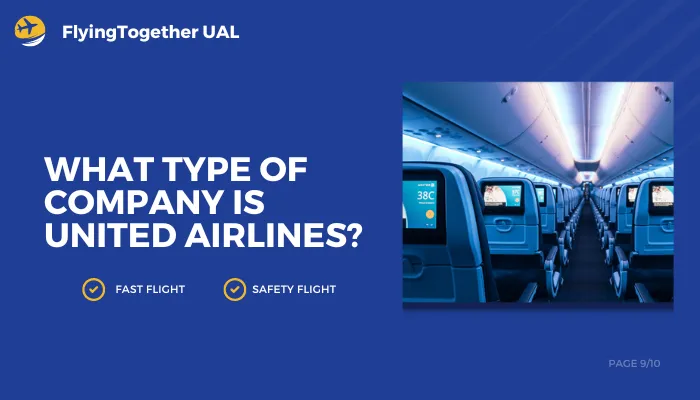This article addresses the question, ”What Type Of Company Is United Airlines?” We will consider its history, business model, place in the sector, and more to fully portray this aviation giant.
Ever wondered what drives United Airlines? As an industry behemoth in aviation, it handles not only travellers from one continent to another but also is a complex company running behind.

What Kind of Company United Airlines Is?
United Airlines has a long heritage that dates back to the start of commercial aviation.
- Founding and Early Years (1920s-1930s): It all began with the merger between various small airlines forming United Aircraft and Transport Corporation in 1925. This corporation later broke up unveiling United Airlines in 1931.
- Milestones and Expansions (1940s-2000s): The airline expanded rapidly throughout the twentieth century by pioneering transcontinental passenger service flights and acquiring other airlines. Some significant milestones include being the first airline to cross the Atlantic using jet airliners (1958) and establishing key hubs around the USA.
- Challenges and Controversies (2000s-Present): The path towards today’s winning position for United has been fraught with turbulence. In addition, it had experienced financial challenges as well as a series of mergers (including one significant one with Continental Airlines in 2010), and customer service controversies among others.
Understanding where a company has come from is crucial for understanding where it is now. The past mergers and acquisitions at United Airlines make it clear that it is an airline holding a major position(we’ll return once again to this idea).
Understanding How United Airlines Makes Money
At present, there exists a well-thought-through business model that guides United Airlines’ income generation and strategic plans. Here are its main components:
- Overview: United is a passenger airline, that transports people as well as goods through its domestic as well as international networks.
- Revenue Streams: Ticket sales are central to United’s revenues; however, there is also additional income from baggage fees, premium cabin upgrades, in-flight services (food, drinks) and affiliations with loyalty programs. Besides this, there are earnings derived from cargo transport.
- Competitive Advantage: The carrier covers an extensive route network and has a large modern fleet(though some aircraft are older), moreover it is a member of the Star Alliance – a global airline alliance offering a seamless transition for passengers.
Through understanding the company’s business model, we can identify “What type of company is United Airlines?”. It operates as a profit-making passenger airline by using its network, services and strategic alliances to compete effectively in the aviation industry.
Structure of United Airlines’ Corporation
United Airlines like any other big organization has a defined hierarchy that guides decision-making and day-to-day operations.
- Organizational Hierarchy: The Board of Directors determines the firm’s strategy and then appoints a CEO who runs the top management team. This group consists of various heads of departments responsible for particular operations zones.
- Key Departments and Divisions: Several departments have been put in place to facilitate various functions within United. This includes Operations (flight management, ground handling), Marketing & Sales, Customer Service, Human Resources, Finance and Safety among others.
- Leadership Team: The Chief Executive Officer coordinates with other members leading the team consisting of presidents in charge of such major areas of activity as regional operations or passenger airlines including cargo services.
To understand United’s corporate structure is to help visualize “What type of company is United Airlines?” It’s a complicated entity that has various divisions working together for smooth flight operations and positive customer experience.
Analyzing United Airlines’ Market Position
The airline industry is a dynamic and competitive one. Let us see where United Airlines stands:
- Airline Industry Overview: The global airline industry is broad with many players that provide both domestic and international passenger as well as cargo services. Fuel prices, economic conditions and government regulation all play major roles in shaping its dynamics.
- United’s Position in the Market: United Airlines is a large airline holding firm majoring among the largest globally both by revenue and fleet size. Also, other local giants like Delta Air Lines, Inc., American Airlines, Inc. and some international airlines are competitors.
- Comparison with Competitors: While United has the advantage of a wide network presence and being part of global alliance partners, their rival might offer more affordable rates on certain routes or newer aircraft than theirs.
By analyzing United’s position in the market, we solidify our understanding of “What type of company is United Airlines?“. It’s one of the main actors in an extremely competitive field always striving to be set apart through its connectivity, services offered as well as strategic partnerships it enters into.
Examining United Airlines’ Legal & Financial Standing
Knowing what makes up a corporation legally and financially helps to understand how healthy it is overall. We’ll explore these elements regarding United Airlines.
- Legal Entity: A publicly traded company on NYSE (UAL), this branch called United Airlines belongs to its parent company – United Airlines Holdings Inc. This structure separates ownership from operations thereby opening the way for public investment into such businesses.
- Regulatory Framework: Government agencies such as the Federal Aviation Administration (FAA) in the United States and their international counterparts have heavy controls over the airline sector. These laws and regulations ensure industry safety, security, as well as fair competition.
- Compliance and Governance: To maintain its operating certificates and public trust, United Airlines adheres to a strict set of compliance guidelines. Safety protocols, financial reporting standards and non-discrimination policies are part of this.
Analyzing United’s legal and financial framework helps us answer the question of “What type of company is United Airlines?“. It is a publicly traded corporation faced with complex regulatory environments where striking a balance between profitability and conformity to safety plus legal requirements is important.
Social Responsibility at United Airlines
Modern companies understand that social responsibility matters. Let’s delve into United’s initiatives within this context.
- Sustainability Initiatives: Included in these programs implemented by United include investments in fuel-efficient aircraft and search for alternative fuels to power jets among other measures aimed at reducing the environmental burden.
- Community Engagement: Education, diversity, and environment are some focal areas for United to support various community programs along with charities involved in projects targeting them.
- Corporate Social Responsibility Efforts: By encouraging ethical business practices, it hopes to give back to its communities through donations while also promoting workforce diversity within its organization on one hand or another
By examining United’s social responsibility efforts we gain insight into “What type of company is United Airlines?”. It is not just a transportation provider; but an entity that recognizes the need to be socially responsible working towards sustainability.
Conclusion
“What type of company is United Airlines?” By taking this journey, we can answer this question with certainty. United Airlines is a many-sided company. United Airlines confronts an ever-changing industry landscape. The technology will continue advancing while customer expectations will change, therefore making it necessary for the company to adjust its strategies.
